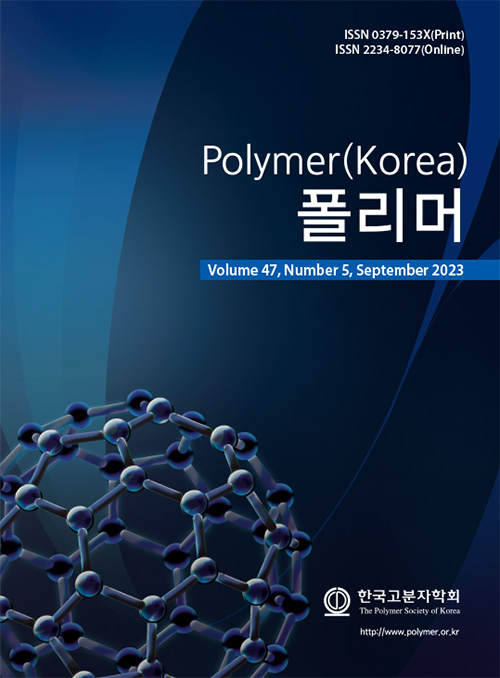- Influence of Stacking Sequence and Orientation on Tensile and Flexural Properties of Jute/glass/carbon Fiber Epoxy-based Hybrid Composites
Rajesh Kumar Dewangan, Samarjit Singh†
 , Biplab Das, Manish Bhaskar, Pradeep Patanwar, Pankaj Kumar Gupta, Sung Soo Han*, and Rakesh Bhaskar*,†
, Biplab Das, Manish Bhaskar, Pradeep Patanwar, Pankaj Kumar Gupta, Sung Soo Han*, and Rakesh Bhaskar*,† 
Department of Mechanical Engineering, School of Studies of Engineering & Technology, Guru Ghasidas Vishwavidyalaya, Bilaspur, Chhattisgarh-495009, India
*School of Chemical Engineering, Yeungnam University, Gyeongsan-38541, Korea- 황마/유리/탄소섬유 에폭시 기반 하이브리드 복합재료의 인장 및 굴곡 특성에 대한 적층 순서 및 배향의 영향
Rajesh Kumar Dewangan · Samarjit Singh†
 · Biplab Das · Manish Bhaskar · Pradeep Patanwar · Pankaj Kumar Gupta · 한성수* · Rakesh Bhaskar*,†
· Biplab Das · Manish Bhaskar · Pradeep Patanwar · Pankaj Kumar Gupta · 한성수* · Rakesh Bhaskar*,† 
Department of Mechanical Engineering, School of Studies of Engineering & Technology, Guru Ghasidas Vishwavidyalaya, Bilaspur
*영남대학교 화학공학부Reproduction, stored in a retrieval system, or transmitted in any form of any part of this publication is permitted only by written permission from the Polymer Society of Korea.
Natural fiber-reinforced epoxy composites have attracted the attention of researchers around the globe owing to their inherent noble attributes such as eco-friendly nature, lightweight, and low cost. However, these composites suffer from inferior mechanical properties and thus, continuous efforts are being made to improve the mechanical properties of these composites. The present work focuses on the tensile and flexural properties of jute (J)/glass (G)/carbon (C) fiber hybrid epoxy laminate composites in inter-ply and angle-ply configurations fabricated using the conventional hand lay-up technique. The impact of stacking sequence and orientation of fibers on the tensile and flexural behavior of epoxy laminate composite samples were evaluated. The results show that the hybrid arrangement of JCGs composite laminate has excellent tensile and flexural properties compared to the GJCs composite laminate at both 0° and 45°/-45° orientation of fiber layers. Therefore, it is possible to manufacture eco-friendly hybrid epoxy composites with encouraging mechanical properties.
천연섬유 강화 에폭시 복합재료는 친환경성, 생분해성, 경량성, 저렴한 가격과 같은 탁월한 특징으로 인해 연구자들의 주목을 받고 있으나 물성이 열악하여 기계적 물성을 개선하기 위한 노력이 계속되고 있다. 천연섬유와 합성섬유를 조합하여 하이브리드 에폭시 복합재료를 만들면 천연섬유 강화 에폭시 복합재의 기계적 물성을 크게 개선할 수 있다. 본 연구는 국제적으로 주목받는 황마(J)/유리(G), /탄소(C) 섬유 하이브리드 에폭시 라미네이트 복합재의 인터플라이 및 앵글플라이 배치에서의 인장 및 굴곡 특성에 초점을 두고 제작하여, 이러한 물성에 대한 섬유의 적층 순서와 방향성의 영향을 평가했다. 복합재의 배열순서의 효과를 보면, JCGs의 배열의 경우가 GJCs 배열의 경우 보다, 섬유층의 0° 및 45°/-45° 배향 모두에서, 우수한 인장 및 굴곡 특성을 가졌다. 또한, 인장 강도, 인장 탄성률, 굴곡 강도, 굴곡 탄성률, 강성 및 연성의 경우에도 유사한 결과를 나타내었다. 따라서, 비교적 약한 물성을 가지는 천연섬유를 포함한 복합재료 제조시, 동일한 재료의 조합이지만, 오직 배열의 순서만 바꾸어서, 보다 우수한 기계적 성질을 가지는 복합재료를 제조할 수 있어, 우수한 기계적 성질을 가지는 친환경 하이브리드 에폭시 복합재료의 개발이 가능할 것이다.
Keywords: natural fibers, carbon fibers, glass fibers, mechanical property, epoxy-resin based hybrid composite, stacking sequence, fiber orientation.
- Polymer(Korea) 폴리머
- Frequency : Bimonthly(odd)
ISSN 0379-153X(Print)
ISSN 2234-8077(Online)
Abbr. Polym. Korea - 2022 Impact Factor : 0.4
- Indexed in SCIE
 This Article
This Article
-
2023; 47(5): 574-581
Published online Sep 25, 2023
- 10.7317/pk.2023.47.5.574
- Received on Jan 28, 2023
- Revised on Apr 26, 2023
- Accepted on Jun 13, 2023
 Correspondence to
Correspondence to
- Samarjit Singh, Rakesh Bhaskar*
-
Department of Mechanical Engineering, School of Studies of Engineering & Technology, Guru Ghasidas Vishwavidyalaya, Bilaspur, Chhattisgarh-495009, India
*School of Chemical Engineering, Yeungnam University, Gyeongsan-38541, Korea - E-mail: samarjitsingh05@gmail.com, indiaxenobiotic@gmail.com









 Copyright(c) The Polymer Society of Korea. All right reserved.
Copyright(c) The Polymer Society of Korea. All right reserved.